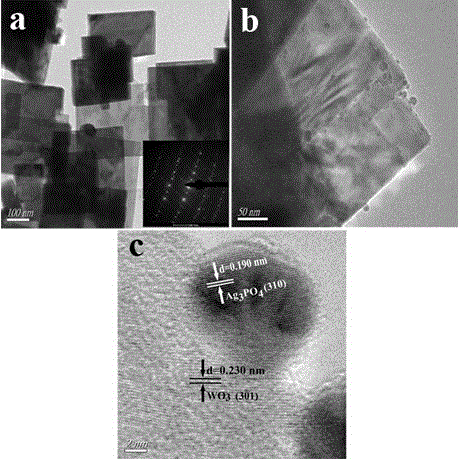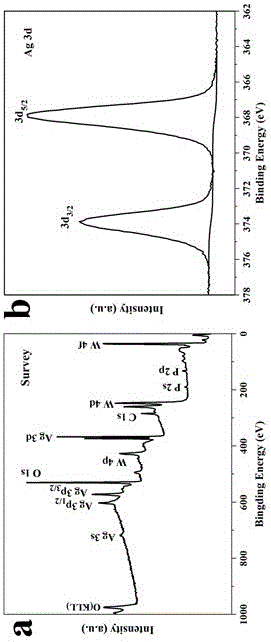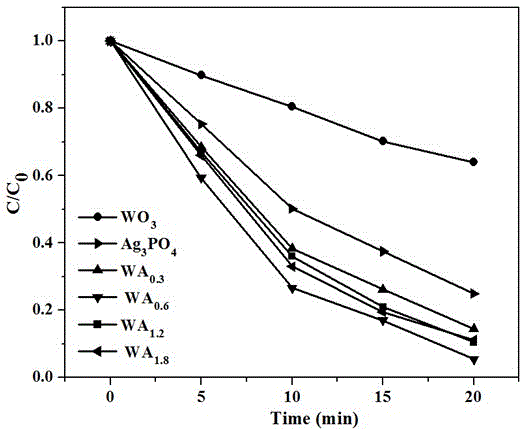Heterojunction nanosheet photocatalyst and preparation method and application of heterojunction nanosheet photocatalyst
A photocatalyst and heterojunction technology, applied in the field of photocatalytic materials, can solve the problems of low photon utilization efficiency, easy recombination of electrons and holes, and ineffective use of solar energy.
- Summary
- Abstract
- Description
- Claims
- Application Information
AI Technical Summary
Problems solved by technology
Method used
Image
Examples
Embodiment 1
[0021] (1) Tungsten oxide: Dissolve 1 mmol, 1.5 mmol, and 3 mmol of sodium tungstate in 25 mL of deionized water, and then add 5 mL of concentrated nitric acid to obtain a mixed solution A; transfer the mixed solution A to polytetrafluoroethylene Among the stainless steel reaction kettles with vinyl fluoride liner, the preferred reaction kettle is the stainless steel reaction kettle with polytetrafluoroethylene liner. The reaction temperature is set at 180°C, and the reaction time is 3 h. After the reaction is completed, cool to room temperature. The cooling method is Natural cooling, or other common physical cooling methods, wash with deionized water and ethanol, and dry by vacuum drying or natural drying to obtain tungsten oxide powder. The morphology of tungsten oxide is in the form of nano flakes by taking SEM images. , and when the sodium tungstate is 1.5 mmol, the morphology is the most regular.
[0022] (2) Compounding of silver phosphate and tungsten oxide: Dissolve 1 ...
Embodiment example 2
[0024] (1) Tungsten oxide: Fully dissolve 1.5 mmol of sodium tungstate in 25 mL of deionized water, then add 5 mL of concentrated nitric acid to obtain a mixed solution A; transfer the mixed solution A to the stainless steel reaction of the polytetrafluoroethylene liner In the kettle, the preferred reaction kettle is a stainless steel reaction kettle with a polytetrafluoroethylene liner. The reaction temperature is set to 180°C, and the reaction time is set to 1 h, 3 h, and 6 h respectively. After the reaction is completed, cool to room temperature and The method is natural cooling, or other common physical cooling methods, washed with deionized water and ethanol, and dried by vacuum drying or natural drying to obtain tungsten oxide powder; the morphology of tungsten oxide is investigated by taking SEM images. The morphology of tungsten oxide is the most regular when the reaction time is 3 h.
[0025] (2) Compounding of silver phosphate and tungsten oxide: Dissolve 1 mmol of t...
Embodiment example 3
[0027] (1) Tungsten oxide: Fully dissolve 1.5 mmol of sodium tungstate in 25 mL of deionized water, then add 5 mL of concentrated nitric acid to obtain a mixed solution A; transfer the mixed solution A to the stainless steel reaction of the polytetrafluoroethylene liner In the kettle, the preferred reaction kettle is a stainless steel reaction kettle with a polytetrafluoroethylene liner. The reaction temperature is set at 160°C, 180°C, and 200°C respectively, and the reaction time is 3 h. After the reaction is completed, cool to room temperature. For natural cooling, or other common physical cooling methods, wash with deionized water and ethanol, dry by vacuum drying or natural drying to obtain tungsten oxide powder, wash the obtained precipitate with deionized water and ethanol, and vacuum After drying by drying or natural drying, tungsten oxide powder is obtained; the morphology of tungsten oxide is examined by taking SEM images, and the tungsten oxide is in the shape of nano...
PUM
 Login to View More
Login to View More Abstract
Description
Claims
Application Information
 Login to View More
Login to View More - R&D
- Intellectual Property
- Life Sciences
- Materials
- Tech Scout
- Unparalleled Data Quality
- Higher Quality Content
- 60% Fewer Hallucinations
Browse by: Latest US Patents, China's latest patents, Technical Efficacy Thesaurus, Application Domain, Technology Topic, Popular Technical Reports.
© 2025 PatSnap. All rights reserved.Legal|Privacy policy|Modern Slavery Act Transparency Statement|Sitemap|About US| Contact US: help@patsnap.com



